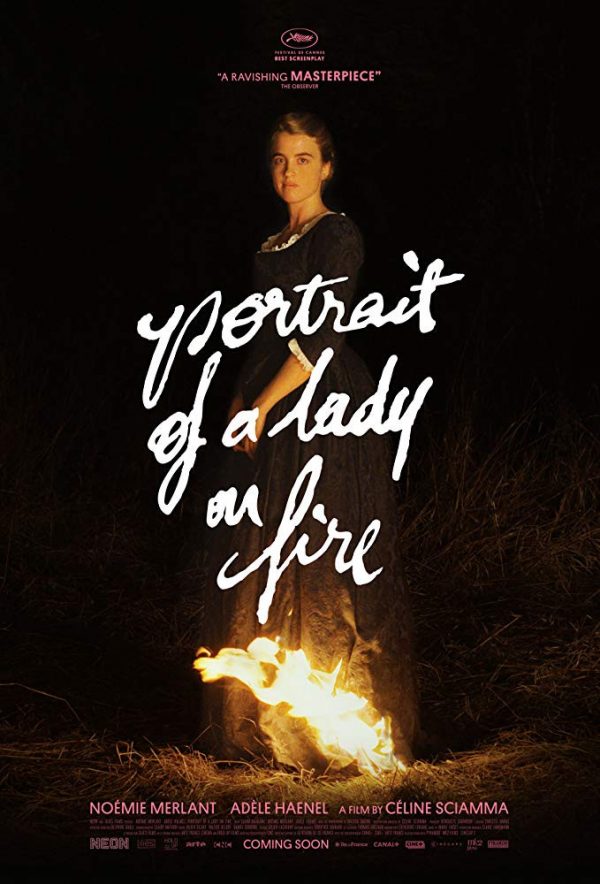Portrait of a Lady on Fire. 2019
Written and Directed by Céline Sciamma
Starring Noémie Merlant, Adèle Haenel, Luàna Bajrami, and Valeria Golino
SYNOPSIS:
On an isolated island in Brittany at the end of the eighteenth century, a female painter is obliged to paint a wedding portrait of a young woman.
Every scene, spoken word of dialogue, and display of body language is crucial and informative to writer and director Céline Sciamma’s slow-scorching Portrait of a Lady on Fire. Halfway through the devastatingly beautiful lesbian romance, its two central 18th-century ladies begin vocally revealing the tiles and signs they have picked up on each other over their brief time knowing one another so far; gestures with such subtlety and nuance that it’s difficult not to be compelled to go back to the beginning of the film and start paying more close attention yourself with greater knowledge. If the film was bad this would, obviously, be frustrating, but Portrait of a Lady on Fire is so transfixing that repeat viewings are a craving following the mesmerizingly poetic ending.
That climax is also a culmination of everything mentioned above, with the film’s deliberate pacing searing every individual image and poignant line into the mind. At one point, these characters discuss Greek mythology, specifically the tragedy of Orpheus and Eurydice, and how it relates to their own simmering dynamic. Naturally, much of what is discussed becomes left behind but not forgotten, tucked away as Easter Eggs inside future paintings as memories never to be taken from time. Similarly, it’s another aspect that almost demands further analysis although much of it is also impactfully straightforward.
Employed to paint a wedding portrait of Héloïse (Adèle Haenel delivering a masterful performance founded almost entirely in body language and facial expressions), what begins as a job for Marianne (Noémie Merlant matching Haenel every step of the way) that must be conducted in secret considering Héloïse’s refusal to pose (she is entirely against the arranged marriage her countess mother has set up, also coping with anger and sadness stemming from the probable suicide of her own sister) evolves into a deep affection for one another related with all of the previously mentioned visual cues. The two begin to discuss everything from music to their true feelings, not only for one another but the bottled up emotions they harbor. One of the first instances of Héloïse letting her guard down actually comes when Marianne has the boldness to simply ask a question that no one dares ask, and from there trust is established as a bond tightens.
Portrait of a Lady on Fire intentionally gives away the trajectory of where this romance is headed (the bulk of the story is a flashback) because the destination of the narrative is not the point. It’s the 18th century, meaning there’s only one way this short-lived but volcanically passionate love ends. Women don’t have a choice, further made evident by a cleverly interwoven side story involving a maid clandestinely undergoing an abortion after confiding in the two women. These women don’t have control of their own bodies let alone their lives, but through Marianne’s painter artistry, their perceptions can be drawn and conserved in secrecy until the end of time. There’s also a hint of horror as Marianne begins hallucinating visions of Héloïse in a wedding dress; a mutual love that runs so deep on borrowed time inescapably waiting to be stolen.
Unsurprisingly, the artwork on display is as exquisite as Claire Mathon’s cinematography, as Céline Sciamma chooses to let nearly every shot linger on facial expressions of desire, creatively playing with blocking (there’s a shot on the beach or the woman are looking off into the distance before sublime camerawork shifts to show Héloïse staring at Marianne). Not to mention, the rocky shoreside of Brittany, France itself is marvelously photographed with a number of wide shots. Naturally, the period piece costumes (Marianne even regularly and symbolically is seen wearing red) and production design are excellent, but Céline Sciamma also smartly makes fire itself a motif with candles or fireplaces burning in nearly every frame. At one point an unworthy painting of Héloïse is set ablaze, and it’s no coincidence that the origin of the flame stems from the heart. Meanwhile, the compositions from Jean-Baptiste de Laubier and Arthur Simonini are as minimalistic as the script itself, with silence allowing that fire to permanently crackle, savoring music to be utilized for maximum dramatic effect. It unquestionably pays off during the breath-stealing grand finale.
Sure to somewhat disappoint the male gaze (and rightfully so), Portrait of a Lady on Fire is less concerned with 10-minute unsimulated sex scenes, wholly fixated on the emotions that words and glances convey following physical intimacy; it’s a two-hander character study about women, by a woman. It’s not without erotic moments, but Céline Sciamma wants men and women to feel the ethereal desires, the struggles of women, and every ounce of pain left behind. As someone with Blue is the Warmest Color barely carving out a spot on my top 50 of the decade list I plan on sharing sometime in December, Portrait of a Lady on Fire challenges me to rethink the authenticity of that film regardless of how powerful I found it to be. That also speaks volumes for the necessity of diverse film voices, especially when it comes to women receiving a larger pedestal to tell these stories.
Nevertheless, the climax allows Héloïse to unleash every single one of those emotions in an extended finale centered on, you guessed it, body language. If pictures can speak 1,000 words, Portrait of a Lady on Fire is all-encompassing visual storytelling dogged to never cease chattering; Adèle Haenel’s fiery range threatens to not only set Héloïse ablaze, but any device tasked with playing the movie. The heat emanating from her radiant performance is nuclear, never to be extinguished.
Flickering Myth Rating – Film: ★ ★ ★ ★ ★ / Movie: ★ ★ ★ ★
Robert Kojder is a member of the Chicago Film Critics Association and the Flickering Myth Reviews Editor. Check here for new reviews, friend me on Facebook, follow my Twitter or Letterboxd, check out my personal non-Flickering Myth affiliated Patreon, or email me at MetalGearSolid719@gmail.com















